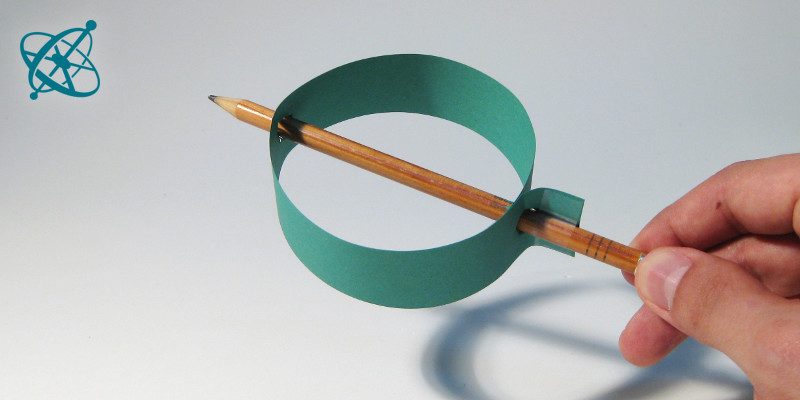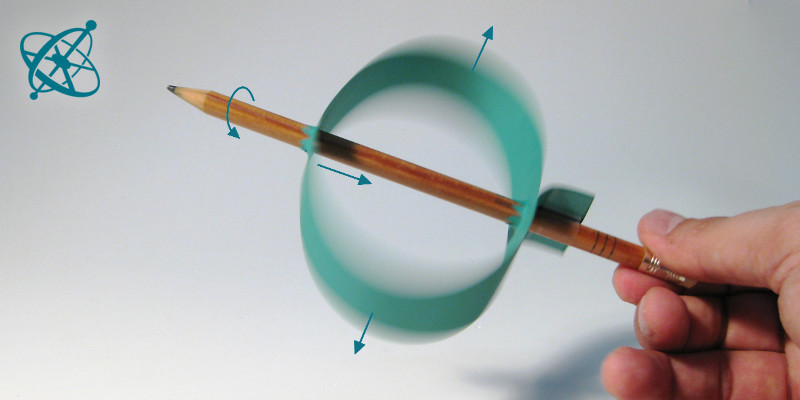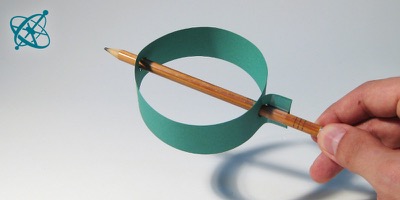 www.sciensation.org | Ciênsação hands-on experiments are published as Open Educational resources under a Creative Commons Attribution-ShareAlike 4.0 International License.
www.sciensation.org | Ciênsação hands-on experiments are published as Open Educational resources under a Creative Commons Attribution-ShareAlike 4.0 International License.
Our Earth is an ellipsoid of revolution – just like this paper stripe.

Without rotation, the stipe's shape is more circular…

…but when spinning the pencil, the centrifugal force pulls at the lopes.

How to fix the stripe's ends.
The Earth is.. ellipsoid
The Earth is not flat. But it is not a sphere either: Due to the rotation around its own axis, the Earth is bulging at the equator. But does this mean that one feels heavier or lighter at the equator compared to the poles?
Centrifugal forces flatten the Earth to an ellipsoid of revolution.
Objects on the Earth's surface experience a small centrifugal force which is larger near the equator than near the poles.
Pencil
Sticky tape
To save teaching time, cut paper stripes (about 30 x 3 cm) and punch holes in the middle and about 2 cm from each end. Show your students how to mount the model with a sample you made, or by projecting some of the images above.
Push a pencil through the holes so that the stripe forms a loop. Then fix the ends of the stripe as seen in the picture and widen the hole at the top, so that the paper can move freely on the pencil. Once your model is ready, rotate the pencil around its axis with increasing speed.
1. Why does the stripe flattens to an oval?
2. The Earth is flattened by its rotation just like the paper stripe. Does this mean that a person has a different weight on the equator than on the poles?
What force is pulling the lobes outwards?
› The centrifugal force.
Does the same force also act on objects on the Earth's surface?
› Yes.
Due to the elliptical shape, there is more mass straight below a person standing on the equator than below a person standing on the pole. Is the gravity at the equator therefore stronger?
› No, it is not just the mass straight below us that exerts a gravitational force, but all the mass of the Earth. Actually, because the person on the equator is further away from the Earth's center of gravity than a person on the poles, she experiences a slightly lower gravity.
The correct answer to this question is less relevant than the arguments your students develop! In fact, a person standing on the equator will weight less than on the pole for at least 3 reasons:
1) The same centrifugal force flattening the paper stripe is also acting on the person, reducing its weight (but not its mass!) by ca. 0.35 %.
2) As the spinning stripe shows, the equator is further away from the center of the Earth than the poles. In the case of the Earth, this difference is about 21.4 km or 0.3% of the Earth radius. The gravitational force between the Earth and the person is therefore slightly smaller (about 0.5 %) on the equator than on the pole.
3) A person on either pole would wear warm and heavy clothes, while a person standing at the equator would probably wear less.



